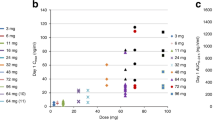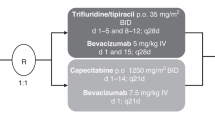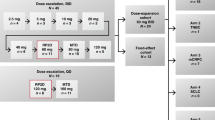Abstract
In the past 5–10 years there has been a growing trend for substituting conventional 5-fluorouracil with the oral prodrug of 5-fluorouracil, capecitabine, in chemotherapy regimens. This regimen change is based on evidence of the efficacy equivalence of these two drugs and the lack of an increase in overall toxic effects when capecitabine is used. Many investigators in different parts of the world have determined their own starting dose for capecitabine, usually based on their experience of toxic events within the population of patients they treat. This starting dose is usually between 1,000–1,250 mg/m2, which is generally administered twice daily for 14 days followed by 7 days rest. This Review summarizes why there may indeed not be a universally applicable starting dose for capecitabine because of interpatient differences in basic physiology, pharmacogenomics and diet. This article also explores which of these factors contribute to the observed inter-regional geographical variation in capecitabine toxicity, and explains why even within a region various factors should prompt a clinician to modify the starting dose.
Key Points
-
Capecitabine is an oral fluoropyrimidine prodrug that is selectively converted within cancer cells to the active drug 5-fluorouracil
-
Clinical trials have indicated that capecitabine is a safe and useful alternative to 5-fluorouracil in the treatment of solid tumors, especially when there is a desire to avoid the use of indwelling venous catheters
-
The starting dose of capecitabine varies in different regions of the world
-
Individual patient exposure to capecitabine and its active metabolites will depend upon a number of factors including age, sex, body weight, hepatorenal function, concomitant drug exposure, pharmacogenetic imprinting, and dietary folate intake
-
Individual clinicians should attempt to consider as many of these factors as possible before selecting an appropriate dose of capecitabine for their patients
This is a preview of subscription content, access via your institution
Access options
Subscribe to this journal
Receive 12 print issues and online access
$209.00 per year
only $17.42 per issue
Buy this article
- Purchase on Springer Link
- Instant access to full article PDF
Prices may be subject to local taxes which are calculated during checkout


Similar content being viewed by others
References
Hoff PM et al. (2001) Comparison of oral capecitabine versus intravenous fluorouracil plus leucovorin as first line treatment in 605 patients with metastatic colorectal cancer: results of a randomised phase III study. J Clin Oncol 19: 2282–2292
Cassidy J et al. (2007) XELOX vs. FOLFOX4: efficacy results from XELOX-1/NO16966, a randomized phase III trial in first-line metastatic colorectal cancer (MCRC) [abstract #270]. In Proceedings of the Gastrointestinal Cancers Symposium: 2007 January 19–21; Orlando, FL
Scheithauer W et al. (2003) Oral capecitabine as an alternative to i.v. 5-fluorouracil-based adjuvant therapy for colon cancer: safety results of a randomized, phase III trial. Ann Oncol 14: 1735–1743
Maughan TS et al. (2002) Comparison of survival, palliation and quality of life with three chemotherapy regimens in metastatic colorectal cancer: a multicentre randomised trial. Lancet 359: 1555–1563
European Medicines Agency (online 31 March 2005) Scientific discussion [http://www.emea.europa.eu/humandocs/PDFs/EPAR/Xeloda/282200en6.pdf] (accessed 21 February 2008)
Gieschke R et al. (2002) Population pharmacokinetic analysis of the major metabolites of capecitabine. J Pharmacokinet Pharmacodyn 29: 25–47
Gieschke R et al. (2003) Population pharmacokinetics and concentration-effect relationships of capecitabine metabolites in colorectal cancer patients. Br J Clin Pharmacol 55: 252–263
Twelves C et al. (2005) Capecitabine as adjuvant treatment for stage III colon cancer. N Engl J Med 352: 2696–2704
Chan R and Kerr DJ (2004) Can we individualize chemotherapy for colorectal cancer? Ann Oncol 15: 996–999
Gross E et al. (2003) High-throughput genotyping by DHPLC of the dihydropyrimidine dehydrogenase gene implicated in (fluoro)pyrimidine catabolism. Int J Oncol 22: 325–332
Hattori K et al. (2003) Design and synthesis of the tumour-activated prodrug of dihydropyrimidine dehydrogenase (DPD) inhibitor, RO00948889 for combination therapy with capecitabine. Bioorg Med Chem Lett 13: 867–872
Largillier R et al. (2005) Pharmacogenetics of capecitabine in advanced breast cancer patients. Clin Cancer Res 12: 5496–5502
Haller DG et al. (2006) Tolerability of fluoropyrimidines appears to differ by region. J Clin Oncol 24 (Suppl): 3514
Schmoll H-J et al. (2007) Phase III trial of capecitabine plus oxaliplatin as adjuvant therapy of stage III colon cancer: a planned safety analysis in 1864 patients. J Clin Oncol 25: 102–109
Shirao K et al. (2004) Comparison of the efficacy, toxicity and pharmacokinetics of Uracil/Tegafur (UFT) plus oral leucovorin (LV) regimen between Japanese and American patients with advanced colorectal cancer: Joint United States and Japan study UFT/LV. J Clin Oncol 22: 3466–3474
Choumenkovitch SF et al. (2002) Folic acid intake from fortification in United States exceeds predictions. J Nutr 132: 2792–2798
De Bree A et al. (1997) Folate intake in Europe: recommended, actual and desired intake. Eur J Clin Nutr 51: 643–660
Branda RF et al. (1998) Nutritional folate status influences the efficacy and toxicity of chemotherapy in rats. Blood 92: 2471–2476
Branda RF et al. (2002) Diet modulates the toxicity of cancer chemotherapy in rats. J Lab Clin Med 140: 353–368
Ho C et al. (2005) Outcomes in elderly patients with advanced colorectal cancer treated with capecitabine: a population-based analysis. Clin Colorectal Cancer 5: 279–282
Sharma R et al. (2006) A phase II study of fixed-dose capecitabine and assessment of predictors of toxicity in patients with advanced/metastatic colorectal cancer. Br J Cancer 94: 964–968
Lokich J (2004) Capecitabine: fixed daily dose and continuous (non-cyclic) dosing schedule. Cancer Invest 22: 713–717
Cunningham D et al. (2002) Efficacy, tolerability and management of raltitrexed (Tomudex) monotherapy in patients with advanced colorectal cancer, a review of phase II/III trials. Eur J Cancer 38: 478–486
van Laarhoven HW et al. (2003) In vivo monitoring of capecitabine metabolism in human liver by 19fluorine magnetic resonance spectroscopy at 1.5 and 3 Tesla field strength. Cancer Res 63: 7609–7612
Author information
Authors and Affiliations
Corresponding author
Ethics declarations
Competing interests
The authors declare no competing financial interests.
Rights and permissions
About this article
Cite this article
Midgley, R., Kerr, D. Capecitabine: have we got the dose right?. Nat Rev Clin Oncol 6, 17–24 (2009). https://doi.org/10.1038/ncponc1240
Received:
Accepted:
Published:
Issue Date:
DOI: https://doi.org/10.1038/ncponc1240
This article is cited by
-
Phase I pharmacological study of continuous chronomodulated capecitabine treatment
Pharmaceutical Research (2020)
-
CREATE-X a role for capecitabine in early-stage breast cancer: an analysis of available data
npj Breast Cancer (2017)
-
Pharmacogenetics-Guided Phase I Study of Capecitabine on an Intermittent Schedule in Patients with Advanced or Metastatic Solid Tumours
Scientific Reports (2016)
-
Chronomodulated oxaliplatin plus Capecitabine (XELOX) as a first line chemotherapy in metastatic colorectal cancer: A Phase II Brunch regimen study
Cancer Chemotherapy and Pharmacology (2016)
-
A phase 0 clinical trial of novel candidate extended-release formulations of capecitabine
Cancer Chemotherapy and Pharmacology (2016)



